Pros and Cons of LED Lighting
Table of Contents
Choosing the proper lighting often leads many to consider LEDs a top contender, given their rapid popularity. LEDs have overshadowed traditional lighting options such as halogen and incandescent bulbs within a short span. But what accounts for this surge in popularity? Understanding the pros and cons of LED lighting might provide some clarity.
LED lights come with a plethora of advantages. Notably, their energy efficiency, longevity, and ease of maintenance stand out. Moreover, their absence of harmful gases or toxic chemicals underscores their environmental friendliness. However, they are not without their downsides, such as the blue LEDs’ potential for causing light pollution and impacting eyesight. Nevertheless, LEDs continue to be a superior choice over conventional lighting alternatives.
This piece delves into LED lights‘ benefits and potential pitfalls. Additionally, I’ll recommend suitable LED lighting solutions for your unique needs. Let’s delve deeper.
What is LED Lighting?

The term LED stands for Light-Emitting Diodes. This cutting-edge lighting technology produces light by channelling electricity through semiconductors. Their energy efficiency and robustness set them apart, making them a preferred replacement for traditional light sources like incandescent or fluorescent lamps.
The Mechanism Behind LEDs
LEDs operate differently, unlike traditional lighting forms, where electricity heats filaments to produce light. They harness the phenomenon of electroluminescence to emit light.
The semiconductor within an LED has two distinct layers: n-type and p-type. The n-type layer is electron-rich, while the p-type layer has ‘holes’ due to an electron deficit.
As electricity courses through the diodes, electrons from the n-type layer leap into the p-type layer’s holes via the p-n junction. This movement of electrons from areas with a high concentration to those with a lower concentration results in visible light emission.
In essence, the brilliance of LEDs comes from the migration of electrons.
Pros of Using LED Lighting
LEDs are currently the leading choice for lighting applications globally, and there are several compelling reasons for this trend. Here’s a breakdown of the benefits offered by LED lighting:
Energy Savings:
LEDs utilize significantly less power compared to conventional lighting solutions. They provide the same brightness but consume 5-8 times less energy than incandescent bulbs.
Traditional incandescent bulbs dissipate much of their energy as heat, resulting in notable inefficiencies. On the other hand, LEDs primarily convert energy to light, making them energy-conserving and cost-effective.
Superior Light Directionality:
Conventional bulbs release light indiscriminately in every direction. This design causes some light to be confined within reflectors or diffusers and some to scatter undesirably, leading to glare.
LEDs benefit from a compact design and directional emission, ensuring efficient light delivery. With the right strategy, LED systems can achieve an optical efficiency surpassing 90%.
Economic Benefits:
Not only do LEDs reduce energy costs, but their sturdy design also means they’re less prone to breaking compared to fragile glass bulbs. Their longevity translates to fewer replacements and, thus, more savings.
Quick Response Time:
LEDs light up nearly instantaneously, taking only between 140 and 220 milliseconds. In contrast, compact fluorescent lights might need up to three minutes to attain maximum brightness.
Moreover, frequently toggling LEDs on and off, unlike other light sources such as incandescent or fluorescent lamps, doesn’t diminish their lifespan.
Consistent Illumination:
Uneven lighting can strain the eyes and impede tasks. LEDs address this issue effectively by providing uniform light distribution. This feature enhances visual comfort and offers better flexibility during functions.
Tailored Light Spectrum
LED technology facilitates tailored spectral designs to cater to specific human visual and psychological needs. This means you can exert more influence over the spectral output for various illuminations. For example, RGB or RGBW LED strips provide countless colour combinations for decorative lighting. Tunable white LED strips also let you fine-tune light spectra by modulating colour temperature and light intensity.
Brightness Adjustment
Traditional fluorescent lights fall short when it comes to dimming capabilities and are pricier. In contrast, LEDs shine in their ability to adjust brightness. Remarkably, LEDs offer two methods: analogue dimming (CCR) and digital dimming (PWM).
Lighting Mastery with LEDs
LEDs provide enhanced lighting control. They let you tailor the brightness level with intelligent LEDs, even the hue and lighting patterns. This starkly contrasts conventional lights, which don’t have these capabilities.
Safety from Photobiological Hazards
Traditional light sources emitting infrared or UV rays pose photobiological risks. However, LEDs don’t emit harmful infrared rays, ensuring no harm to skin or eyes. For context, fluorescent and incandescent bulbs produce significant amounts of infrared energy. Additionally, LED’s UV emission is minimal, making them a safer and more eco-friendly lighting choice.
Mitigated Radiation Impact
Conventional lights emit radiant energy beyond the visible light spectrum, leading to photobiological hazards. These emissions can damage art, dehydrate produce, and even melt confectionery. LEDs, however, emit radiant energy strictly within the visible range (400 nm to 700 nm), ensuring artefacts and perishables remain unharmed.
Safety from Fires and Explosions
Traditional bulbs use heated tungsten or excited gases to carry significant fire and explosion risks. LEDs, on the other hand, generate light through electromagnetic radiation in semiconductors. This means they stay calm, making them inherently safer than their traditional counterparts.
LEDs and Visible Light Communication (VLC)
Every LED can serve as a wireless data communication hub, provided its driver can convert digital signals. Capitalizing on this, we now have Li-Fi – a communication system using LEDs’ “ON/OFF” sequences for data transmission. Li-Fi boasts exponentially greater bandwidth and transmission rate than Wi-Fi or Bluetooth.
Direct Current (DC) Illumination
LEDs operate using low-voltage DC grids. This design enhances installation stability, minimizes lighting failures, and demands less upkeep. Furthermore, LEDs outshine incandescent lights in efficiency by up to 75%.
Minimal Heat Production
LEDs operate coolly like traditional bulbs, which waste over 90% of electricity as heat. This makes them efficient and perfect for lighting-sensitive items like artworks vulnerable to UV exposure.
Operation in Frigid Climates
Fluorescent bulbs struggle in cold environments, necessitating high start-up voltages. LEDs, conversely, perform seamlessly even below -50°C, making them the go-to for fridges, freezers, cold storage, and outdoor settings.
Tailor-made Lighting
LEDs offer a palette of lighting options. For example, an intelligent RGB LED strip allows endless colour combinations. Users can blend primary colours to achieve their preferred hues.
Integration with Smart Homes
A standout feature of LEDs is their adaptability with intelligent devices. Users can link them to smartphones via Wi-Fi or Bluetooth for streamlined operation, a concept unfathomable with traditional bulbs.
Analog LED Dimming
Analog LED dimming remains a popular choice for standard lighting. It operates via constant current reduction (CCR), which manages the current flow. However, its downside is a less optimal performance when the current flow drops below 10%.
Digital LED Dimming
Utilizing pulse width modulation (PWM) technology, digital LED dimming minimizes power loss during the dimming process. For instance, LEDs with a PWM dimming system can achieve 3000:1 or even superior dimming ratios (at 100Hz) without compromising precision.
Versatile Design
The design versatility of LEDs is unmatched. Their compact nature permits varied applications. They come in many designs, from LED bulbs and tube lights to flexible strips and neon lights, making LEDs a top pick for any lighting necessity.
Longevity
LEDs outlive conventional incandescent bulbs by a significant margin. While incandescent bulbs last a few thousand hours, LEDs boast lifespans ranging from 35,000 to 80,000. They can outlast halogens by 20-25 times and CFLs by 8-10 times.
Compact Design
One of LED lights’ standout features is their compactness, especially in LED strips. They’re notably lightweight, hassle-free to set up, and versatile. Despite their small stature, LEDs don’t compromise on brightness. These diminutive lights can match the brilliance of traditional fluorescents while consuming less energy.
Focused Illumination
While incandescent and CFL bulbs disperse light in a 360-degree pattern, LEDs provide targeted illumination over a 180-degree area. This targeted emission minimizes light pollution and prevents unwanted glare. Consequently, LEDs harness the energy and deliver light more resourcefully than their traditional counterparts.
Low Upkeep
Frequent replacements aren’t a concern with LED lights, negating the need for routine maintenance. This translates to savings in energy, money, and time. Their low-maintenance nature also makes them ideal for remote locations.
Sturdy Build
Unlike the fragile glass components of incandescent and halogen lamps, LEDs produce light from semiconductor blocks. This means no more worrying about shattered glass. Moreover, LEDs are remarkably durable, withstanding shocks, vibrations, and wear with ease.
Bug Deterrent
Traditional light sources, especially incandescents, magnetize bugs and insects. However, LEDs have shown a reduced attraction to these critters, making them a more practical choice for outdoor use.
User-friendly
LED lights gradually dimmer over time, rather than the sudden burnout in incandescent. This reduces the need for frequent fixture replacements, as seen with other lights.
Eco-Conscious Choice
Distinguishing them from many standard fluorescent bulbs, LEDs lack harmful substances like mercury. Their exceptional energy efficiency complements renewable energy systems like solar power, positioning LEDs as a more eco-friendly lighting alternative.
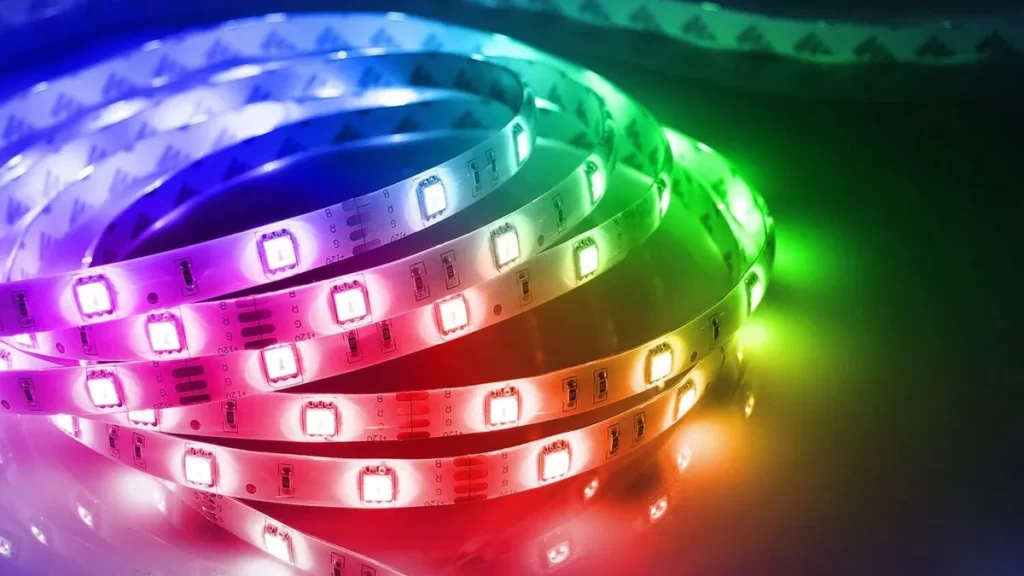
Cons of LED Lighting
While LED lights boast many benefits, there are also drawbacks to keep in mind when deciding on lighting options:
Potential Harm from Blue Light
Blue and cool white LEDs emit blue light that can lead to more glare and vision impairment. Research indicates that blue light can contribute to muscular degeneration and damage to the eye’s photoreceptor cells. Thus, some blue LEDs can be detrimental to our eyes.
Blue Light Pollution
Cool white LEDs have a higher blue light pollution rate than traditional lighting. This excessive blue light can disrupt natural circadian rhythms, affecting regular sleep patterns. To mitigate these effects, opting for warm-tone LED lighting, such as dim-to-warm LED strips, and avoiding white LEDs with a correlated colour temperature above 3,000K is advisable.
Voltage Sensitivity
LEDs are particularly vulnerable to unsuitable voltage levels. Even minor voltage discrepancies can significantly impact an LED system. Thus, ensuring the correct voltage is crucial for maintaining LED longevity.
Limited Light Distribution
Traditional light sources like fluorescent and incandescent lamps offer a more widespread, spherical light distribution. In contrast, the directional nature of LEDs restricts them from providing a similar light spread, limiting their capability to diverge light.
Higher Initial Cost
When considering price points, halogen lights are generally cheaper. The advanced LED technology makes them more efficient and expensive upfront. For example, while a halogen bulb might cost $3, a standard LED might cost $10 or more. However, due to LEDs’ longer lifespan and lower maintenance needs, they often prove to be more cost-efficient in the long run.
Incompatibility Issues
Existing lighting controllers, primarily designed for incandescent lights, often don’t align with the dimming mechanisms of LEDs. As a result, integrating LED lights might necessitate an added expense for a compatible LED controller.
Categories of LED Bulbs
LED bulbs can be grouped into two main types based on their construction:
Standard LED Bulbs
Standard LED bulbs feature chips that are placed on an aluminium circuit board. Unlike conventional halogen or incandescent bulbs made of glass, LED bulbs utilize a plastic enclosure, enhancing their durability.
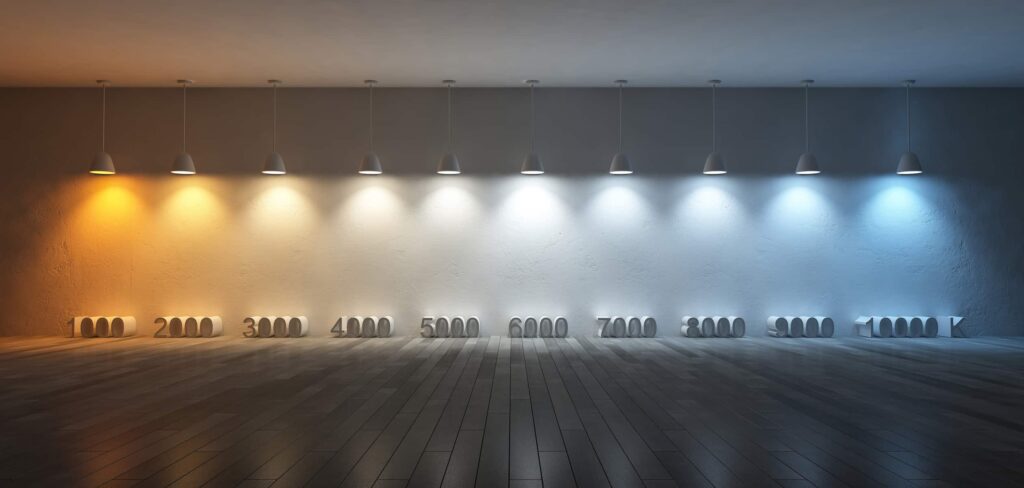
Filament LED Bulbs
Filament LED bulbs consist of tiny LED chips that come together to create filament wires. These filaments are coated with a yellow phosphorus layer, producing a warm glow. They are housed in a glass casing, imparting a conventional bulb aesthetic. However, filament LEDs have a higher price tag due to their vintage look and are often chosen for chandeliers.
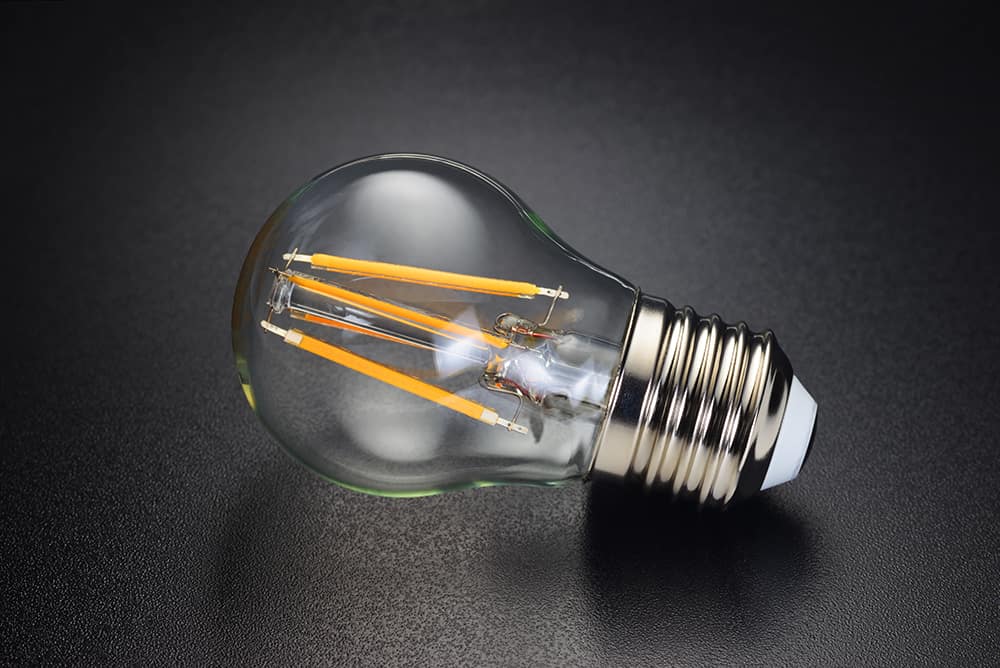
Varieties of LED Lighting Technologies
LED lights come in a diverse array of technological variations. These can be categorized into the following four types:
1. Dual In-Line Package (DIP) LEDs:
Traditional in design, DIP LEDs feature a plastic-covered chip with two straight, parallel connectors. Though less efficient than some of their contemporaries, they can produce about 4 lumens per LED.
| Advantages | Disadvantages |
| Can’t go smaller than 10mm pixel pitch, smaller viewing angle, Higher production and manufacturing cost | Can’t go smaller than 10mm pixel pitch, smaller viewing angle, Higher production and manufacturing cost |
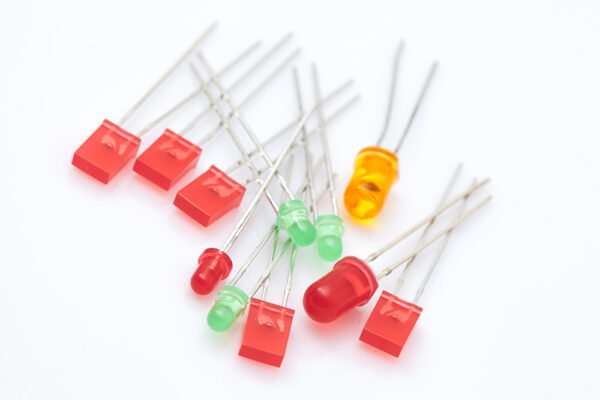
2. Surface Mounted Diode (SMD) LEDs:
SMD LEDs are positioned directly onto circuit board surfaces. They outshine DIP LEDs in terms of efficiency and brightness. While a DIP LED requires three separate bulbs for RGB, an SMD LED can incorporate all three diodes on one chip, making it more compact and providing a range of lighting possibilities.
| Advantages | Disadvantages |
| Small in size ( 2mm indoors and 5mm outdoors)Higher lighting resolution, better viewing angles Better colour accuracy, and slightly improved reliabilitySupports versatile light-controlling options | It uses more energy in comparison to DIP LEDsHarder to Service May create dots (can be avoided using high-density SMD LEDs) |
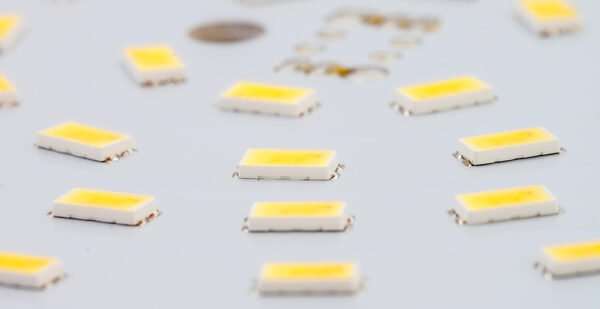
3. Chip on Board (COB) LEDs:
COB LED technology embeds chips directly on a base, like a PCB or silicon, forming LED clusters. This design allows for brighter output than both DIP and SMD LEDs. In addition, they are energy savers, and their method often includes numerous diodes (usually nine or more) on a single chip.
| Advantages | Disadvantages |
| Lower repairability, limited colour selection, more expensive than SMD chips | Softer repairability, Limited color selection, more expensive than SMD chips |

4. Chip Scale Package (CSP) LEDs:
Representing cutting-edge technology, CSP LEDs deliver the brightest light output in the smallest available package — often as small as the LED chip or just slightly larger. Their design eliminates the need for soldered wire connections, minimizing thermal resistance and potential points of light failure.
| Advantages | Disadvantages |
| Better heat dissipation, Higher lumen density, holder and alloy wiring requirements, Fewer production processes, More flexible & reliable | Poor light transmittance price, Ghosting phenomenon of backlight penetration. |
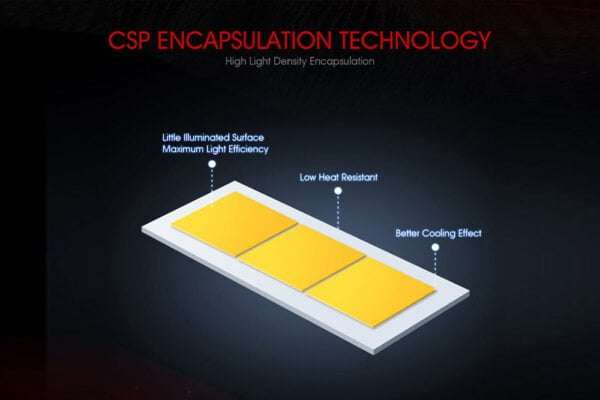
Reasons to Opt for LED Strip Lighting
LED strip lights are a prominent category in LED lighting solutions due to their adaptability and functionality. They’re suitable for an array of both interior and exterior applications. While LED strips provide myriad reasons to select them over other lighting methods, let’s dive into some of their most compelling features.
1. Flexibility
With their rope-like design, LED strips are incredibly bendable, making installing them a breeze. Their lightweight nature adds to their convenience. Moreover, they can be resized or cut, ensuring they fit perfectly wherever you need them.
2. Versatility
LED strips excel in diverse lighting scenarios, be it indoors or outdoors. They have technology that facilitates intensity, dimming, and colour temperature adjustments. Whether it’s ambient lighting in living spaces, task lighting in workplaces, or decorative lighting for businesses, these strips rise to the challenge.
3. Comprehensive Light Control
Options such as RGBX, Tunable White, and addressable LED strips put you in the driver’s seat when determining light colour and brightness. For example, RGB strips can produce a vast palette of colours, while tunable white stripes let you shift from cosy to crisp white tones. The unique dim-to-warm strips make a soothing, candlelight ambience. Notably, with addressable LED strips, individual sections can display different colours, creating dynamic multicoloured effects.
4. Customization
LED strips, especially those from MyLikeLed, come with various tailoring options, allowing users to specify everything from length and power requirements to branding details. They’re a go-to solution, irrespective of whether the application is personal, commercial, or industrial.
5. Hassle-free Setup
The user-friendly nature of LED strips means they’re simple to install without professional help. Given their adaptability, you can craft bespoke lighting designs easily.
6. Weather-resistant
Durability against moisture is vital, especially for outdoor settings. MyLikeLed’s offerings, with IP67 and IP68 ratings, ensure waterproof performance.
7. True-to-life Color Reproduction
The Color Rendering Index (CRI) gauges the quality of light in replicating natural colours. MyLikeLed’s strips, boasting high CRIs of Ra>90 / Ra>95, deliver lifelike colours, making them ideal for environments where colour accuracy is crucial.
8. Cost Efficiency and Longevity
LED strips are wallet and eco-friendly, consuming minimal energy while maximizing brightness. They outlast traditional lighting solutions, and as a testament to their quality, MyLikeLed backs their strips with a five-year warranty.

Guide to Selecting the Perfect LED Strips
When in the market for LED strips, it’s vital to know the key factors that influence their performance and suitability for your project:
1. Length:
The typical length for LED strip lights is 5 meters per reel. Calculate your needs and select reels that match. For tailor-made measurements, MyLikeLed offers customized solutions tailored to your project.
2. Chip Dimension:
The size of the LED chip plays a pivotal role in determining the luminosity of the light. A larger chip dimension produces a more vibrant lighting effect. For example, an LED strip with a chip size of 5.6mm x 3.0mm (SMD5630) will shine brighter than one measuring 2.2mm x 1.6mm (SMD2216).
3. Color Varieties:
LED strips come in diverse colour options:
- Tunable White: Allows for adjusting white light’s colour temperature, spanning warm to cool shades. You can control the temperature from 1800K to 6500 K, making it ideal for mood lighting.
- Dim-To-Warm: These give a warm, comforting lighting effect ranging from 3000K to 1800K, mimicking the ambience of candlelight. Perfect for bedrooms, they promote relaxation and better sleep.
- Single-Colour: As the name suggests, these produce a singular colour like red, blue, green, etc. They cater to a range of power requirements and protective ratings.
- RGBX: Capable of blending primary colours to yield millions of shades. Popular types include RGB, RGBW, and RGBWW. They are versatile, fitting both indoor and outdoor needs.
- Addressable: These let you control segmented lighting, allowing for multicoloured displays. Their visual appeal and tech advancements earn them titles like “dream colour” or “magic LED strips.”
4. LED Density:
This is the number of LED chips per meter. A higher density equals a smoother light spread. MyLikeLed provides densities from 30LEDs/m to 720LEDs/m. For an uninterrupted light flow, consider COB LED strips.
5. CRI Rating:
A measure of light quality, a higher CRI (> 90) ensures more accurate colour representation.
6. IP Rating:
This rating evaluates the strip’s resistance to solid and liquid elements. For instance, an IP65 rating means the LED strip is dust-resistant but unsuitable for damp areas. For moisture-resistant needs, opt for IP67 or IP68 ratings.
7. Power Consumption:
LED strips come in a range of power consumption levels, from 2.4w/m up to 30w/m. Additionally, MyLikeLed provides tailored choices to match your specific power needs for lighting projects.
So, when selecting LED strips for your illumination endeavour, these considerations are crucial. However, if you have any questions, please get in touch with the MyLikeLed support team. We’re here to assist you in finding the perfect strips for your project.
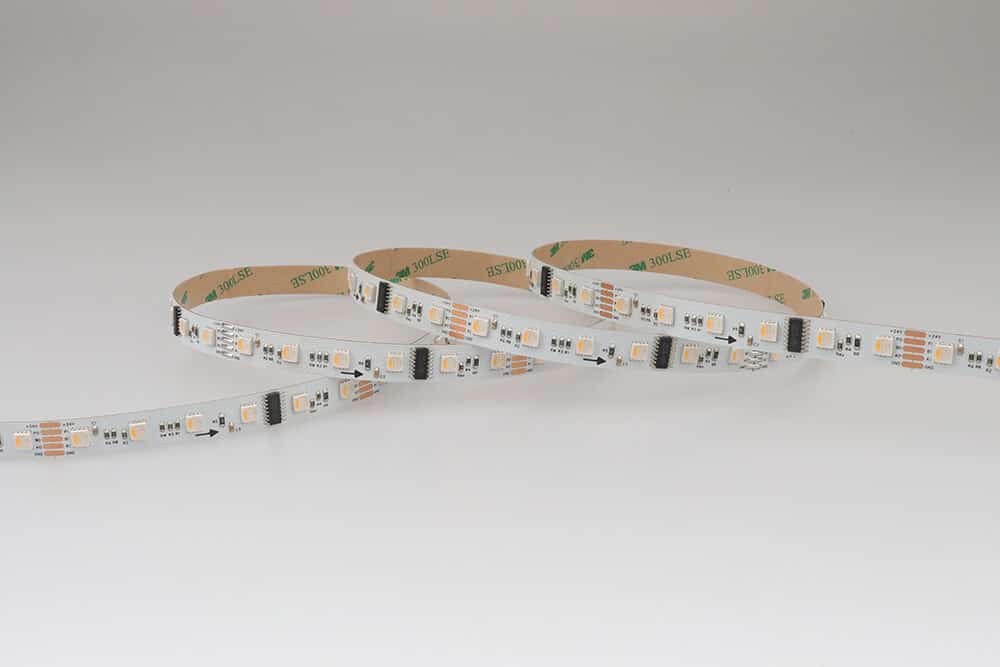
Is LED Lighting Superior to Traditional Lighting?
When contrasting LED lighting with traditional lights, let’s decipher which stands out as superior:
- Traditional lights, such as incandescent bulbs, illuminate by converting merely 10% of their consumed energy into light. A staggering 90% dissipates as heat. In contrast, LEDs are proficient in energy usage, translating most of their input energy into light. This makes LED lights about 75% more energy efficient than their traditional counterparts.
- LED lights boast a longer lifespan, up to 25 times more than conventional halogen bulbs.
- Conventional bulbs incorporate mercury and emit UV and IR rays, posing environmental concerns. On the other hand, LED lights are free from harmful gases and don’t emit IR rays, ensuring they’re environmentally friendly and safer for human health.
- The performance of LED lights remains consistent across temperature variations, functioning efficiently in both chill and warmth. Conversely, some traditional lights, like fluorescent bulbs, may struggle in colder temperatures.
- Traditional lighting solutions often use fragile glass components, which can be sensitive to temperature changes and prone to breakage. LEDs, being made from durable plastic, are inherently more resilient.
Utilizing LED Strips for Outdoor Illumination: Is it Feasible?
Absolutely! LED strips are excellent choices for outdoor illumination. They can be employed for purposes like signage, facade lighting, architectural highlights, events outdoors, pool illumination, street lights, and more. However, checking their resistance against dust and water is crucial when choosing them for outdoor use. Hence, LED strips with a high IP rating are recommended since they would be exposed to environmental challenges such as dust, rainfall, and storms.
In Summary
LED lighting presents many notable benefits, some of which have been highlighted above. They stand out for their energy efficiency, eco-friendliness, and longevity. Moreover, they outshine conventional lights for performance in challenging weather conditions. However, some downsides exist, like potential blue light hazards and environmental concerns linked to blue LEDs. Proper selection and implementation of LED options can mitigate these concerns.
LED strips, in particular, are among the most adaptable and user-friendly in the vast array of LED lighting solutions. They suit various lighting needs, from indoor bedrooms to marine environments. Don’t hesitate to contact MyLikeLed for the ideal LED strip tailored to your illumination requirements!
FAQs
LED lights use up to 80% less energy than traditional incandescent bulbs and about 50% less energy than fluorescent lights. This high efficiency translates to lower electricity costs, making them a sustainable and cost-effective lighting solution.
Yes, LED lights are environmentally friendly because they use less energy, which reduces carbon emissions. Additionally, they do not contain hazardous materials like mercury, which is found in fluorescent lights. LEDs are also fully recyclable, making them a more eco-conscious lighting option.
No, LED lights produce very little heat compared to incandescent or halogen bulbs. Traditional bulbs waste a lot of energy in the form of heat, whereas LEDs convert most of their energy into light, which keeps surrounding areas cooler. This makes them safer to use and helps reduce cooling costs in homes and buildings.
The main disadvantages of LED lighting include their higher upfront cost compared to traditional bulbs and sensitivity to temperature and humidity in certain environments. While LEDs save money over time, the initial investment may be a concern for some. Additionally, poorly designed LEDs can cause uneven lighting or may flicker if not properly installed.
LED lights can last up to 50,000 hours or more, depending on the quality of the bulb and usage conditions. This is 10-25 times longer than traditional incandescent bulbs, which typically last about 1,000 hours. With such a long lifespan, LED lights help reduce the frequency and cost of replacements.
Yes, many LED lights are dimmable if they are compatible with dimmer switches. However, it’s important to use dimmable LED bulbs and ensure that your dimmer switch is also compatible. Non-dimmable LEDs may flicker or not work properly with traditional dimmer switches, so it’s crucial to choose the right combination for your needs.

Hi, I’m Xylia Xiong, a sales professional with 14 years of experience in the LED strip light industry. I specialize in providing tailored solutions, leveraging my expertise in LED products and the latest industry trends. Known for effective communication and problem-solving, I’m dedicated to helping lighting manufacturers, importers, and distributors achieve their goals.
Let’s work together to create customized solutions that exceed expectations.
Related Posts

The Best LED Strip Lights You Can Buy Right Now

Comparing WS2811 Vs WS2812B: Key Differences


